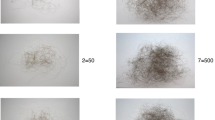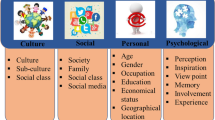Abstract
As ubiquitous commerce using IT convergence technologies is coming, it is important for the strategy of cosmetic sales to investigate the sensibility and the degree of preference in the environment for which the makeup style has changed focusing on being consumer centric. The users caused the diversification of the facial makeup styles, because they seek makeup and individuality to satisfy their needs. In this paper, we proposed the effect of the facial makeup style recommendation on visual sensibility. Development of the facial makeup style recommendation system used a user interface, sensibility analysis, weather forecast, and collaborative filtering for the facial makeup styles to satisfy the user’s needs in the cosmetic industry. Collaborative filtering was adopted to recommend facial makeup style of interest for users based on the predictive relationship discovered between the current user and other previous users. We used makeup styles in the survey questionnaire. The pictures of makeup style details, such as foundation, color lens, eye shadow, blusher, eyelash, lipstick, hairstyle, hairpin, necklace, earring, and hair length were evaluated in terms of sensibility. The data were analyzed by SPSS using ANOVA and factor analysis to discover the most effective types of details from the consumer’s sensibility viewpoint. Sensibility was composed of three concepts: contemporary, mature, and individual. The details of facial makeup styles were positioned in 3D-concept space to relate each type of detail to the makeup concept regarding a woman’s cosmetics. Ultimately, this paper suggests empirical applications to verify the adequacy and the validity of this system.







Similar content being viewed by others
Notes
MISSHA Ltd., http://www.missha.ae
Amore Pacific Co. Ltd., http://www.amorepacific.com
Mary Kay, http://www.marykay.co.kr
Fujitsu, http://www.fujitsu.com
LG Household & Healthcare Ltd., http://www.lgcare.com
References
Behrens R (2000) A Grammar based Model for XML Schema Integration. Proc. of the British National Conference on Databases, pp 172–190
Chung KY (2011) Sensibility ergonomics fashion recommendation system using weather WebBot. Proc. of the International Conf. on Information Science and Applications 2011, pp 712–717, IEEE Computer Society
Chung KY, Rim KW, Lee JH (2011) Performance sensibility influence of recommended makeup styles. Proc. of the 1st International Conference IT Convergence and Security, LNEE 120, pp 445–454, Springer
Eisenthal Y, Dror G, Ruppin E (2006) Facial attractiveness: beauty and the machine. Neural Comput 18(1):119–142
Herlocker JL, Konstan JA, Terveen LG, Riedl JT (2004) Evaluating collaborative filtering recommender systems. J ACM Trans Inf Syst 22(1):5–53
Jalali M, Mustapha N, Sulaiman N, Mamat A (2010) WebPUM: a web-based recommendation system to predict user future movements. J Expert Syst Appl 37(9):6201–6212
Jung KY (2010) Human sensibility ergonomics makeup recommendation system using context sensor information. J Korea Contents Assoc 10(7):23–30
Jung YG, Han MS, Chung KY, Lee SJ (2011) A study of a valid frequency range using correlation analysis of throat signal. Information 14(11):3791–3799
Jung KY, Lee JH (2004) User preference mining through hybrid collaborative filtering and content-based filtering in recommendation system. IEICE Trans Inf Syst E87-D(12):2781–2790
Jung KY, Na YJ (2004) Developing textile design recommendation system according to customer’s sensibility. J Text Inst 94(1–6):207–216
Jung KY, Na YJ (2005) Effects of the detail types of ladies wear on the sensibility and emotion. J Korean Soc Cloth Ind 7(2):162–168
Kim JH, Chung KY (2011) Ontology-based healthcare context information model to implement ubiquitous environment. Multimedia Tools Appl. doi:10.1007/s11042-011-0919-6
Kim HN, Jia AT, Haa IA, Joa GS (2010) Collaborative filtering based on collaborative tagging for enhancing the quality of recommendation. J Electron Commer Res Appl 9(1):73–83
Kim HS, Kang IA (2001) A Study on the development of simulation for make-up coordination. J Korean Home Econ Assoc 39(12):65–77
Kim JH, Lee D, Chung KY (2011) Item Recommendation based on Context-aware Model for Personalized u-Healthcare Service. Multimedia Tools Appl. doi:10.1007/s11042-011-0920-0
Kim TH, Yang SB (2005) An improved neighbor selection algorithm in collaborative filtering. IEICE Trans Inf Syst E88-D(5):1072–1076
Kim TH, Yang SB (2005) An effective recommendation algorithm for clustering-based recommender systems. J Adv Artif Intell 3809:1150–1153
Kohrs A, Merialdo B (2001) Creating user-adapted websites by the use of collaborative filtering. J Interact Comput 13(6):695–716
Korea Meteorological Administration, http://web.kma.go.kr/eng/
Lee ME, Cho GS (2009) Measurement of human sensation for developing sensible textiles. J Hum Factors Ergon Manuf 19(2):168–176
Lee KH, Choi HK (2010) Analysis of image expression in make-up illustration. J Korea Contents Assoc 10(7):233–243
Melville P, Mooney RJ, Nagarajan R (2002) Content-Boosted Collaborative Filtering for Improved Recommendations. Proc. of the National Conference on Artificial Intelligence, pp 187–192
Michael T, (1997) Machine learning. McGraw-Hill, New York, pp 154–200
Na YJ (2009) Fashion design styles recommended by consumers’ sensibility and emotion. J Hum Factors Ergon Manuf 19(2):158–167
Song CW, Chung KY, Jung JJ, Rim KW, Lee JH (2011) Localized approximation method using inertial compensation in WSNs. Information 14(11):3591–3600
Wang J, de Vries AP, Reinders MJT (2006) A User-Item Relevance Model for Log-based Collaborative Filtering. Proc. of European Conf. on Information Retrieval, pp 37–48
Acknowledgment
This research was supported by Sangji University that allowed Prof. K. Y. Chung to have the sabbatical year, 2012. Sincere thanks go to Prof. Y. J. Na who provided the idea for 3D-concept space.
Author information
Authors and Affiliations
Corresponding author
Additional information
This paper is significantly revised from an earlier version presented at the 1st International Conference IT Convergence and Security.
Rights and permissions
About this article
Cite this article
Chung, KY. Effect of facial makeup style recommendation on visual sensibility. Multimed Tools Appl 71, 843–853 (2014). https://doi.org/10.1007/s11042-013-1355-6
Published:
Issue Date:
DOI: https://doi.org/10.1007/s11042-013-1355-6




